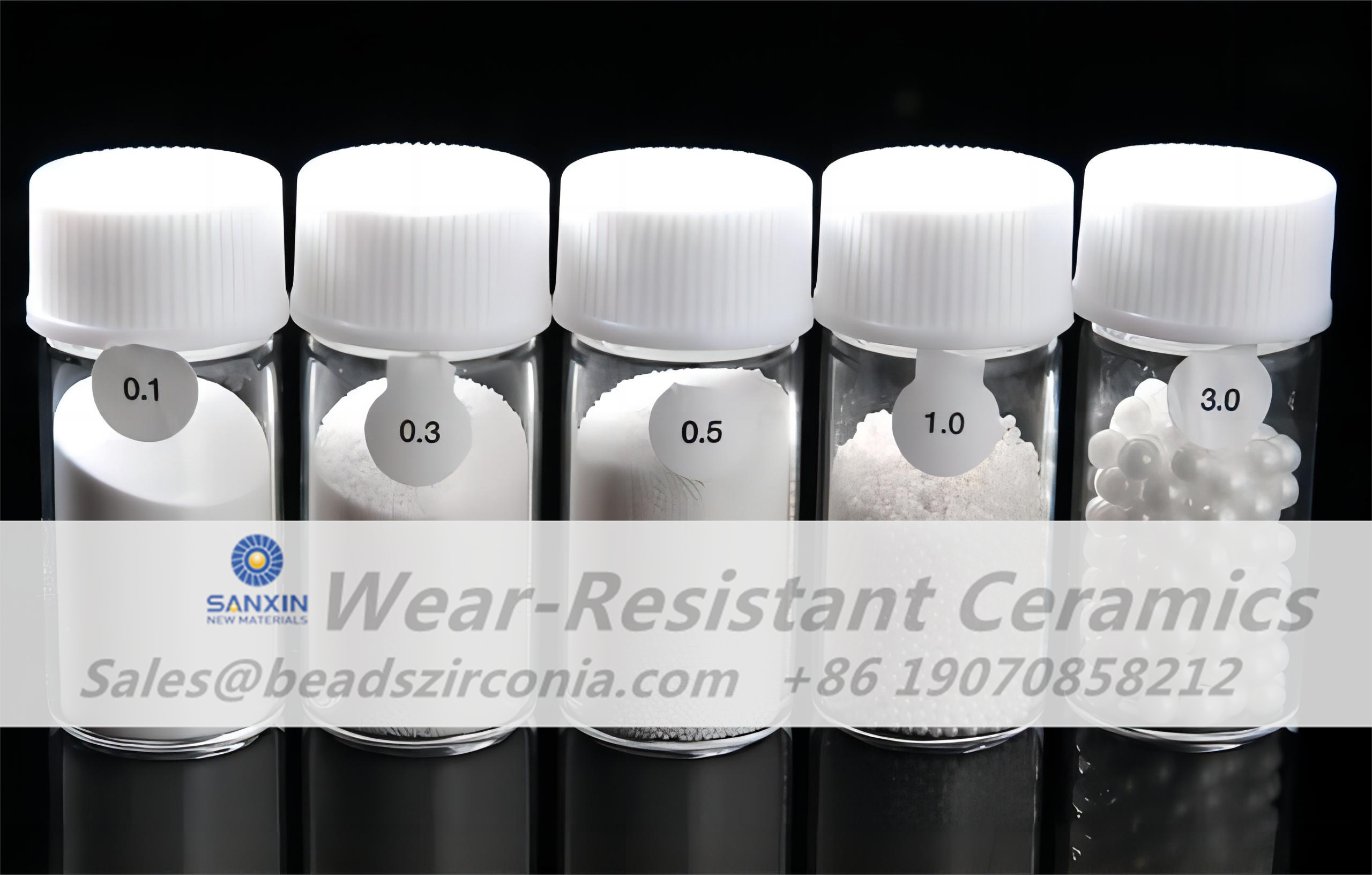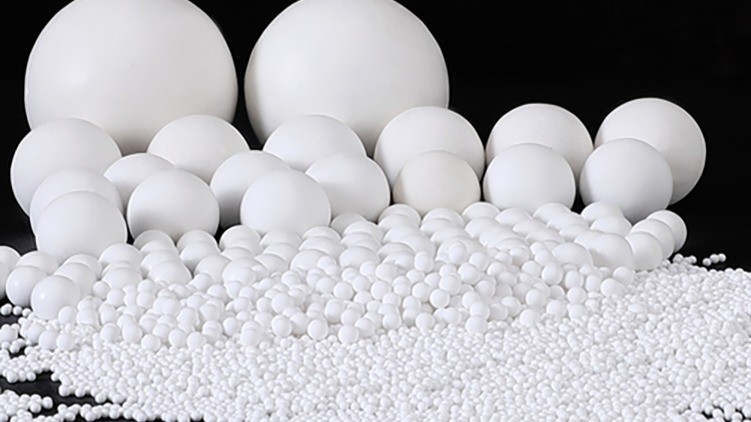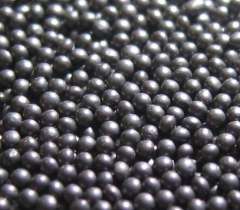Sand milling is a common technique used to reduce particle size in various industries, including paint, ink, mineral processing, and pharmaceuticals. Achieving fine, consistent particle sizes allows for better product quality and performance, from smoother coatings to efficient drug formulations. The media used in the milling process, such as ceramic grinding media, plays a pivotal role in optimizing results by balancing energy efficiency, durability, and contamination control.
Grinding Media refers to particles that assist in the grinding or dispersing of a target material. In sand milling, the grinding media acts by transferring kinetic energy, thereby facilitating particle size reduction. Ceramic grinding media, made from materials like alumina, zirconia, and silicon carbide, provide unique benefits over traditional materials like glass beads and steel balls, enhancing the efficiency of sand milling processes.

The advantages of ceramic grinding media stem from its physical properties and performance characteristics, which are notably superior to conventional grinding media. Here’s an in-depth analysis of these benefits:
Extended Service Life:
The hardness of ceramic media, especially alumina and zirconia types, contributes to its longevity. Harder media resists wear and tear, enduring thousands of milling cycles without significant degradation.
In environments with prolonged milling needs, ceramic media is especially beneficial as it minimizes frequency and cost of replacements, reducing operational downtime.
High Precision and Consistency:
Uniform particle size reduction is critical for applications requiring high precision, such as pharmaceuticals and advanced electronics. Ceramic media’s uniformity ensures that each particle undergoes consistent force application, leading to controlled, predictable particle sizes.
The homogeneity achieved with ceramic media directly translates to product quality and consistency, whether in paints, where uniform pigment dispersion is crucial, or in cosmetics, where a smooth texture is desired.
Reduced Contamination:
Ceramic media, due to its chemically inert composition, minimizes contamination. This is particularly important in sensitive industries where metal contamination from steel balls, for example, could compromise product quality.
With minimal contamination, ceramic media maintains the purity of materials, making it suitable for products that demand high standards of cleanliness, such as pharmaceuticals, personal care items, and food products.
Environmental Sustainability:
Ceramic grinding media, unlike metal or glass, doesn’t contribute significantly to waste or pollution. With a long life cycle and lower replacement rates, ceramic media reduces waste generation, aligning with sustainable production practices.
The variety in ceramic grinding media is extensive, each type optimized for specific properties and applications. The major types include alumina, zirconia, silicon carbide, and hybrid options like zirconia-toughened alumina.

Alumina grinding media is renowned for its high hardness and density, making it ideal for milling applications that require durability. Here’s a closer look:
Purity Levels: Alumina media comes in varying purities, with high-purity options (99.9% alumina) minimizing contamination risks. The purity levels determine suitability in sensitive applications like pharmaceuticals.
Cost-Effectiveness: Alumina is generally more affordable than other ceramic types, which makes it suitable for industries with high media consumption, like the paint and ink industries.
Zirconia is a top choice for high-intensity milling due to its density and resistance to wear. Zirconia media options include pure zirconia and yttria-stabilized zirconia (YSZ), each with unique benefits.
YSZ Advantages: Yttria-stabilized zirconia (YSZ) is tougher and more stable, resisting cracking and shattering under extreme milling conditions. YSZ is especially popular in high-purity applications where no contamination is tolerated.
Price Consideration: Zirconia media is more expensive than alumina, but its extended life cycle and higher efficiency can offset the initial costs in high-value applications.
ZTA offers a blend of alumina’s affordability and zirconia’s toughness, providing a cost-effective option for industries seeking high wear resistance without the cost of pure zirconia.
Balanced Density: ZTA combines moderate density with durability, providing a balance between impact force and wear resistance.
Cost Efficiency: ZTA’s lower price compared to zirconia makes it an attractive choice for medium- to high-wear applications, reducing the need for frequent media replacement.

SiC media, with its extreme hardness and lightweight properties, is ideal for specific precision milling applications, although it’s more prone to fracture under extreme conditions.
Heat Resistance: Silicon carbide can withstand high temperatures, making it suitable for applications involving heat-sensitive materials.
Limited Use: Due to its brittleness, silicon carbide is used mainly in precision applications and specific industries like abrasives, where particle breakage is not a concern.
Different types of sand mills are used with ceramic grinding media, each offering unique benefits and efficiency depending on the media type and milling application. Some popular sand milling systems include horizontal, vertical, and basket mills.
Horizontal Sand Mills:
Horizontal sand mills are widely used for their ability to deliver high efficiency in fine grinding and dispersion. The horizontal orientation enhances particle dispersion by keeping the media in continuous circulation.
Media Compatibility: Ceramic grinding media, particularly denser options like zirconia, work well in horizontal sand mills due to the media’s need for consistent, high-energy impact.
Vertical Sand Mills:
Vertical mills are typically used in applications that don’t require extremely fine particle sizes. These mills offer a cost-effective option for applications with moderate precision needs.
Best Media Types: Alumina and ZTA media types are commonly used in vertical mills for general grinding applications where ultra-fine milling is not required.
Basket Mills:
Basket mills are popular in industries requiring batch processing and low contamination. They are ideal for producing fine particle dispersions in paints, inks, and coatings.
Media Optimization: Basket mills benefit from uniform, small-sized ceramic media like YSZ, which enhances dispersion and avoids clogging in the basket system.
High-Energy Mills:
These mills are used in ultra-fine milling applications requiring extremely high energy. High-energy mills are highly compatible with high-density ceramic media, making zirconia or YSZ optimal for such environments.
Nano-Scale Applications: For nanomaterials or pharmaceuticals requiring ultra-fine milling down to the nano level, high-energy mills paired with YSZ media offer the precision and purity required.
When comparing ceramic grinding media to conventional media options like glass or steel, several performance benefits stand out:
Energy Efficiency:
Ceramic media, especially zirconia and YSZ, has a higher density than glass or steel, allowing for improved energy transfer during milling. This results in faster, more efficient particle reduction.
Traditional media like steel balls consume more energy, as they require greater force to achieve similar results, often resulting in higher operational costs.
Wear Resistance:
Ceramic media, due to its hardness and durability, shows significantly less wear over time compared to metal and glass media. Steel media, for example, wears down faster, leading to contamination issues and more frequent replacements.
Product Quality:
Ceramic media minimizes contamination risks, while steel and glass media can degrade and leach contaminants. This is particularly relevant in sensitive applications like food and pharmaceuticals, where even trace contaminants can affect product safety and efficacy.
Milling Speed: Adjusting milling speed helps to balance media performance and wear. High-density ceramic media may require slower milling speeds to prevent excess wear while still achieving efficient milling.
Temperature Control: Ceramic media can heat up during prolonged milling. Using cooling systems or adjusting milling parameters can prevent overheating, which could impact the media’s structure and reduce its lifespan.
Loading and Filling Ratios: Proper media loading optimizes the milling process by allowing adequate interaction between media and material. Overloading or underloading can reduce grinding efficiency and increase media wear.
As industries advance, so do the materials and techniques used in sand milling. Emerging trends in ceramic media include:
Nanostructured Ceramic Media: Advances in nanotechnology have led to the development of nano-ceramic media. These nano-sized media provide improved milling efficiency for applications demanding ultra-fine particles.
Bio-Ceramic Media: For applications like pharmaceuticals, bio-compatible ceramic media are being explored to further reduce contamination risks.
Sustainable Production: With growing demand for eco-friendly solutions, manufacturers are developing ceramic media with lower environmental impacts, including recyclable options and those made from sustainable raw materials.
In pharmaceutical applications, achieving precise particle size is vital for drug efficacy. A pharmaceutical company producing APIs switched from steel to YSZ ceramic media. This reduced contamination, increased milling precision, and improved overall product quality, supporting regulatory compliance and extending product shelf life.
A paint manufacturer faced issues with inconsistent pigment dispersion, affecting color quality. Switching to alumina ceramic media in a horizontal mill resolved these issues, achieving uniform dispersion, reduced processing times, and lowered material costs.
In mineral processing, a mining company implemented ZTA ceramic media to replace steel balls in a high-energy mill. This change led to better wear resistance, reduced media consumption, and improved mill throughput, optimizing operational efficiency.
Paints and Coatings: In the paint and coatings industry, alumina media is used for dispersing pigments and reducing particle size to achieve a smooth and uniform finish. Its affordability makes it suitable for large-scale production where high quantities of grinding media are required.
Inks and Pigments: For ink production, alumina grinding media provides the necessary hardness to achieve fine particle sizes, ensuring consistent ink quality and flow characteristics.
Ceramic Tile Manufacturing: Alumina is often used in the production of ceramic tiles to grind clay and glaze components. Its hardness ensures efficient milling while maintaining the quality of the tile finish.
Glass and Ceramics: Alumina is compatible with the production of glass and ceramics, as it withstands the milling of abrasive materials without excessive wear.
Cosmetics and Personal Care Products: In the cosmetics industry, alumina media is used for milling ingredients to achieve a smooth texture and fine particle distribution in products like powders, creams, and foundations.
Alumina media is typically selected in these applications for its combination of performance, durability, and lower cost compared to high-purity zirconia or YSZ.
Pharmaceuticals: Zirconia, especially YSZ, is ideal for pharmaceutical applications where purity and precise particle size control are essential. It’s used for milling active pharmaceutical ingredients (APIs), achieving uniform particle sizes critical for drug efficacy.
Nanotechnology: In the development of nanomaterials, zirconia’s high density enables efficient energy transfer for breaking down particles to nano-size. Zirconia media is especially valuable in high-energy mills used in nanotechnology and electronics.
Electronics and Battery Materials: Zirconia is used to mill high-purity electronic materials, such as those found in lithium-ion batteries, to achieve uniform particle sizes, which improve the energy efficiency and durability of batteries.
Advanced Ceramics: In the production of advanced ceramics used in aerospace, automotive, and defense industries, zirconia media ensures a fine, consistent particle distribution, enhancing the performance of high-tech ceramic products.
High-Quality Paints and Coatings: For applications requiring exceptional finish quality, such as automotive coatings, zirconia grinding media can achieve ultra-fine pigment dispersion with minimal contamination.
Zirconia is chosen in these high-precision industries due to its hardness, density, and purity, which together provide superior milling performance and maintain product integrity.
Mining and Mineral Processing: ZTA is often used in the mining industry for processing ores and minerals, providing resistance to abrasive wear and reducing operational costs due to its long life.
General Ceramics Manufacturing: In the manufacturing of general-use ceramics, ZTA provides durability and efficiency, allowing for extended milling sessions without frequent media replacement.
Refractory Materials: For producing refractory materials that withstand high temperatures, ZTA grinding media is used to mill raw materials to fine particles, optimizing the performance of the final product.
Construction Materials: ZTA is suitable for milling materials in the construction industry, such as cement, where its cost-efficiency and hardness support large-scale, continuous milling operations.
Battery Materials: In applications that do not require the extremely high purity of zirconia, ZTA grinding media can be used in battery materials processing, providing a more affordable option for achieving required particle sizes and distribution.
The hybrid nature of ZTA makes it a practical choice in applications where zirconia’s performance is advantageous but cost savings are also a priority.
Abrasives: Silicon carbide is commonly used in the production of abrasive materials, where it mills hard substances into uniform grains for sandpaper, grinding wheels, and other abrasive products.
Ceramic Cutting Tools: In manufacturing ceramic tools, SiC media aids in milling high-hardness materials, ensuring uniformity and enhancing the final tool’s durability and cutting precision.
Refractory Compounds: For producing refractory compounds that must endure high temperatures, silicon carbide grinding media efficiently mills materials, preserving the chemical and thermal stability required in the final product.
Heat-Resistant Coatings: In applications requiring heat-resistant coatings, SiC media mills high-hardness compounds that contribute to the final product’s durability at elevated temperatures.
Specialty Chemicals: SiC media is occasionally used in the specialty chemicals industry for milling materials that require resistance to heat and abrasion, allowing it to handle particularly challenging formulations.
Due to its lightweight and heat resistance, SiC is selected for precision applications that prioritize fine milling without the need for extremely high milling forces.
Choosing the correct type of ceramic grinding media for a specific application is crucial to achieving optimal milling efficiency, product quality, and operational cost-effectiveness. Here’s a summary guide based on application needs:
For Cost-Effective Milling with Moderate Precision: Alumina is suitable for high-volume applications like paint and pigment dispersion, ceramics manufacturing, and inks. Its affordability and performance make it ideal for general-purpose applications.
For High-Purity, Ultra-Fine Milling: Zirconia or YSZ is recommended for pharmaceuticals, electronics, and advanced ceramics. These applications benefit from zirconia’s high density, hardness, and low contamination risk.
For Balanced Performance and Cost Efficiency: Zirconia Toughened Alumina (ZTA) is ideal for industries that require both durability and cost control, such as mining, battery production, and general ceramics. ZTA provides many benefits of zirconia without the associated cost.
For Heat-Resistant and Precision Milling: Silicon Carbide (SiC) is appropriate for specialized applications in abrasives, cutting tools, and refractory compounds. Its lightweight and heat resistance make it effective in these niche applications.
Ceramic grinding media offers a versatile and high-performing solution for sand milling processes across industries. By understanding the unique properties and applications of each type – alumina, zirconia, ZTA, and silicon carbide – industries can optimize their milling processes, improve product quality, and enhance efficiency. The proper selection of ceramic grinding media not only reduces costs and operational downtime but also aligns with specific industry requirements, from pharmaceuticals to abrasives.
With ongoing advancements in ceramic media technology, including nano-media, bio-compatibility, and recyclability, ceramic grinding media is set to play an increasingly vital role in modern manufacturing, fostering innovation, sustainability, and superior product quality across diverse applications.

Submit your demand,
we will contact you ASAP.

Sanxin New Materials Co., Ltd. focus on producing and selling ceramic beads and parts such as grinding media, blasting beads, bearing ball, structure part, ceramic wear-resistant liners, Nanoparticles Nano Powder

